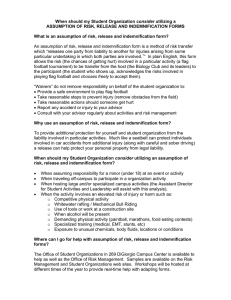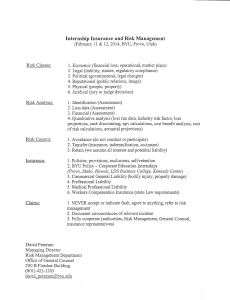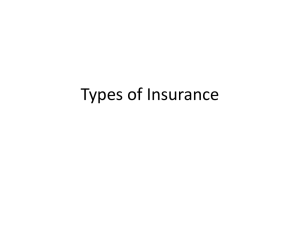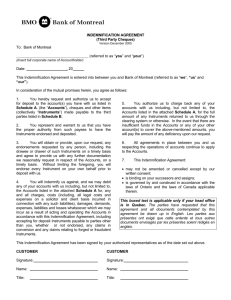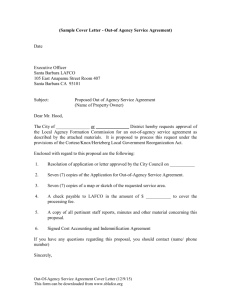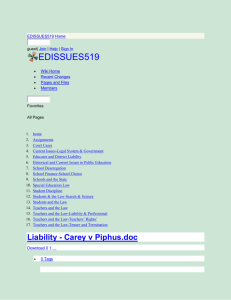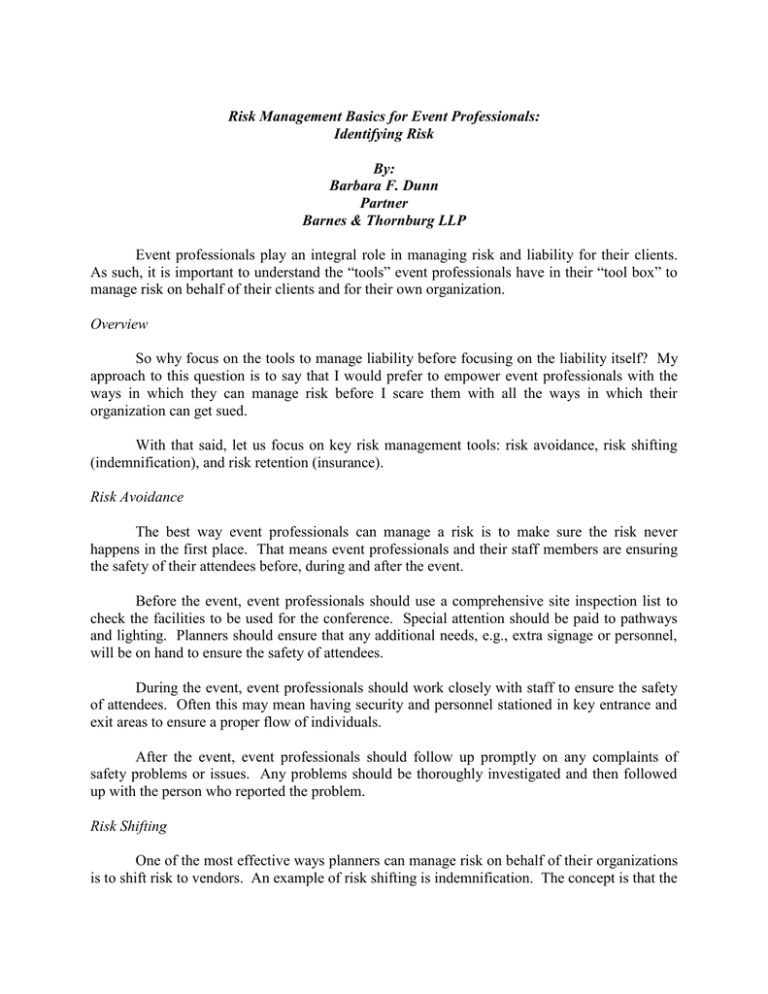
Risk Management Basics for Event Professionals:
Identifying Risk
By:
Barbara F. Dunn
Partner
Barnes & Thornburg LLP
Event professionals play an integral role in managing risk and liability for their clients.
As such, it is important to understand the “tools” event professionals have in their “tool box” to
manage risk on behalf of their clients and for their own organization.
Overview
So why focus on the tools to manage liability before focusing on the liability itself? My
approach to this question is to say that I would prefer to empower event professionals with the
ways in which they can manage risk before I scare them with all the ways in which their
organization can get sued.
With that said, let us focus on key risk management tools: risk avoidance, risk shifting
(indemnification), and risk retention (insurance).
Risk Avoidance
The best way event professionals can manage a risk is to make sure the risk never
happens in the first place. That means event professionals and their staff members are ensuring
the safety of their attendees before, during and after the event.
Before the event, event professionals should use a comprehensive site inspection list to
check the facilities to be used for the conference. Special attention should be paid to pathways
and lighting. Planners should ensure that any additional needs, e.g., extra signage or personnel,
will be on hand to ensure the safety of attendees.
During the event, event professionals should work closely with staff to ensure the safety
of attendees. Often this may mean having security and personnel stationed in key entrance and
exit areas to ensure a proper flow of individuals.
After the event, event professionals should follow up promptly on any complaints of
safety problems or issues. Any problems should be thoroughly investigated and then followed
up with the person who reported the problem.
Risk Shifting
One of the most effective ways planners can manage risk on behalf of their organizations
is to shift risk to vendors. An example of risk shifting is indemnification. The concept is that the
organization shifts risk to the party which can best control the risk. For example, if the
organization is hiring a bus company to transport attendees at their conference, the risk is that the
bus will get into an accident and attendees will get hurt. In this case, the organization shifts that
risk to the bus company by asking the bus company to indemnify the organization in their
contract. The indemnification language states that the bus company will indemnify and hold the
organization harmless (from a financial standpoint) from any claims due to the bus company’s
negligence. Here’s a sample indemnification clause:
"Supplier shall indemnify, defend, and hold harmless [Organization Name], its officers,
directors, employees and agents and each of them (collectively "the indemnitees"), from and
against any and all claims, demands, actions, judgments, costs, and expenses, including costs of
defense thereof, incurred by any of the indemnitees caused by or arising from the negligence,
gross negligence, or intentional misconduct of Supplier, its officers, directors, employees, agents
or contractors."
With this clause in place, should the bus get into an accident, an attendee gets hurt, and
that attendee sues the organization, the organization can invoke its rights under the
indemnification clause and have the bus company hire lawyers to defend the lawsuit on the
company’s behalf right from the beginning and to pay any damages awarded against the
organization.
Indemnification clauses should be part of every contract as there is always the possibility
that the good or service which is being purchased will cause harm to someone and the
organization will be sued. By having indemnification in the contract, the organization knows
that it will be protected in such circumstances.
One last note re: indemnification: It is important to have the organization’s lawyer draft
or review each indemnification provision as this is the type of clause in which one word can
make a difference in the scope of the protection.
Risk Retention (Insurance)
Another way organization can cover their risk is through risk retention. When an
organization purchases insurance, it is agreeing to “retain” the risk (up to the dollar amount of
the deductible). Everything in excess of that deductible is covered by the insurance company.
Let us explore some types of insurance:
General commercial liability insurance is often referred to as GCL or CGL or errors and
omissions insurance. This insurance is the backbone of any organization’s insurance coverage as
it protects against personal injury or death among other things. For example, if an organization
is sued by an attendee who slipped and fell at their event, this liability insurance would cover the
cost of defending the lawsuit along with paying any damages which are awarded against the
organization.
Note that liability insurance coverage should start at 2 million dollars. While many
organizations may have 1 million dollars of coverage, such amount is not sufficient in today’s
dollar terms given the cost to defend a personal injury lawsuit.
As with the indemnification provision, it is important to have the organization’s lawyer
and insurance representative involved in the review of liability insurance to ensure the
organization is getting comprehensive coverage. Of particular concern is the list exclusions, i.e.,
those items which are not covered under the policy. Note that liquor liability claims are typically
excluded from general commercial liability insurance. Given the risk that the organization may
be held liable for liquor liability claims under social host liability (topic to be addressed in the
next column), event professionals should ensure that their organization has obtained an
endorsement or rider to have such claims covered under the policy.
Directors and officers liability insurance is another type of insurance in which the
directors, officers and other key personnel are protected by insurance in the event they are
individually named in a lawsuit.
Property and casualty insurance covers equipment and other property owned by the
organization and insures it against fire, theft or other damage.
Event cancellation insurance is another type of insurance which protects the revenue and
costs associated with the organization’s conference. If the organization would have to cancel its
event entirely or shut it down earlier than scheduled due to weather problems or transportation
strikes, event cancellation insurance would cover the greater of the revenue which would have
been incurred in connection of the event or the expenses incurred in connection with the event.
While this type of insurance no longer provides coverage for acts or terrorism (although
organizations can purchase riders to obtain such coverage), it covers many other occurrences
which could impact a event. Note that many groups which had to cancel spring events in Mexico
due to the government orders surrounding the H1N1 outbreak benefitted greatly from having
event cancellation insurance in place.
Conclusion
So now that you have an understanding of risk avoidance, insurance and indemnification,
you can begin using these “tools” in your work as event professionals to minimize the risk to
your client and your own organization.
Barbara Dunn is a Partner with the Associations and Foundations Practice Group at Barnes &
Thornburg where she concentrates her practice in association law and meetings, travel and
hospitality law. Barbara can be reached at (312) 214-4837 or barbara.dunn@btlaw.com.
©Copyright 2013. Barbara F. Dunn, Barnes & Thornburg LLP. Chicago, Illinois, USA. All
rights reserved under both international and Pan American copyright conventions. No
republication permitted without the express written consent of the copyright holder.

